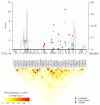A genome-wide association study identifies pancreatic cancer susceptibility loci on chromosomes 13q22.1, 1q32.1 and 5p15.33
- PMID: 20101243
- PMCID: PMC2853179
- DOI: 10.1038/ng.522
A genome-wide association study identifies pancreatic cancer susceptibility loci on chromosomes 13q22.1, 1q32.1 and 5p15.33
Abstract
We conducted a genome-wide association study of pancreatic cancer in 3,851 affected individuals (cases) and 3,934 unaffected controls drawn from 12 prospective cohort studies and 8 case-control studies. Based on a logistic regression model for genotype trend effect that was adjusted for study, age, sex, self-described ancestry and five principal components, we identified eight SNPs that map to three loci on chromosomes 13q22.1, 1q32.1 and 5p15.33. Two correlated SNPs, rs9543325 (P = 3.27 x 10(-11), per-allele odds ratio (OR) 1.26, 95% CI 1.18-1.35) and rs9564966 (P = 5.86 x 10(-8), per-allele OR 1.21, 95% CI 1.13-1.30), map to a nongenic region on chromosome 13q22.1. Five SNPs on 1q32.1 map to NR5A2, and the strongest signal was at rs3790844 (P = 2.45 x 10(-10), per-allele OR 0.77, 95% CI 0.71-0.84). A single SNP, rs401681 (P = 3.66 x 10(-7), per-allele OR 1.19, 95% CI 1.11-1.27), maps to the CLPTM1L-TERT locus on 5p15.33, which is associated with multiple cancers. Our study has identified common susceptibility loci for pancreatic cancer that warrant follow-up studies.
Figures



Similar articles
-
A resequence analysis of genomic loci on chromosomes 1q32.1, 5p15.33, and 13q22.1 associated with pancreatic cancer risk.Pancreas. 2013 Mar;42(2):209-15. doi: 10.1097/MPA.0b013e318264cea5. Pancreas. 2013. PMID: 23295781 Free PMC article.
-
Three new pancreatic cancer susceptibility signals identified on chromosomes 1q32.1, 5p15.33 and 8q24.21.Oncotarget. 2016 Oct 11;7(41):66328-66343. doi: 10.18632/oncotarget.11041. Oncotarget. 2016. PMID: 27579533 Free PMC article.
-
Common variation at 2p13.3, 3q29, 7p13 and 17q25.1 associated with susceptibility to pancreatic cancer.Nat Genet. 2015 Aug;47(8):911-6. doi: 10.1038/ng.3341. Epub 2015 Jun 22. Nat Genet. 2015. PMID: 26098869 Free PMC article.
-
Genome-wide association study identifies five new susceptibility loci for prostate cancer in the Japanese population.Nat Genet. 2010 Sep;42(9):751-4. doi: 10.1038/ng.635. Epub 2010 Aug 1. Nat Genet. 2010. PMID: 20676098
-
Novel genetic variants in the chromosome 5p15.33 region associate with lung cancer risk.Carcinogenesis. 2011 Oct;32(10):1493-9. doi: 10.1093/carcin/bgr136. Epub 2011 Jul 18. Carcinogenesis. 2011. PMID: 21771723 Free PMC article.
Cited by
-
Exploring the Relationship between CLPTM1L-MS2 Variants and Susceptibility to Bladder Cancer.Genes (Basel). 2023 Dec 28;15(1):50. doi: 10.3390/genes15010050. Genes (Basel). 2023. PMID: 38254939 Free PMC article.
-
Tumor cell heterogeneity and its transcriptional bases in pancreatic cancer: a tale of two cell types and their many variants.EMBO J. 2021 Jul 1;40(13):e107206. doi: 10.15252/embj.2020107206. Epub 2021 Apr 12. EMBO J. 2021. PMID: 33844319 Free PMC article. Review.
-
The updated relationship between the cleft‑lip and palate transmembrane protein‑1‑like rs401681 and lung cancer risk: A systematic review and meta‑analysis.Mol Clin Oncol. 2024 Jul 31;21(4):70. doi: 10.3892/mco.2024.2768. eCollection 2024 Oct. Mol Clin Oncol. 2024. PMID: 39113849 Free PMC article.
-
Technical reproducibility of genotyping SNP arrays used in genome-wide association studies.PLoS One. 2012;7(9):e44483. doi: 10.1371/journal.pone.0044483. Epub 2012 Sep 7. PLoS One. 2012. PMID: 22970228 Free PMC article.
-
A common genetic variation of melanoma inhibitory activity-2 labels a subtype of pancreatic adenocarcinoma with high endoplasmic reticulum stress levels.Sci Rep. 2015 Feb 6;5:8109. doi: 10.1038/srep08109. Sci Rep. 2015. PMID: 25657029 Free PMC article.
References
-
- Ferlay J, Bray F, Pisani P, Parkin DM. IARC CancerBase. No. 5. IARCPress; Lyon: 2004. GLOBOCAN 2002: Cancer Incidence, Mortality and Prevalence Worldwide.
-
- Anderson KE,MT, Silverman D. Cancer of the pancreas. In: Schottenfeld D, Fraumeni JJ, editors. Cancer Epidemiology and Prevention. Oxford University Press; New York: 2006.
MeSH terms
Grants and funding
- P50 CA062924-130011/CA/NCI NIH HHS/United States
- R01 CA082729/CA/NCI NIH HHS/United States
- P50 CA062924/CA/NCI NIH HHS/United States
- P50 CA062924-140011/CA/NCI NIH HHS/United States
- R37 CA070867/CA/NCI NIH HHS/United States
- ZIA CP010193-03/ImNIH/Intramural NIH HHS/United States
- R01 CA124908/CA/NCI NIH HHS/United States
- P50 CA102701/CA/NCI NIH HHS/United States
- K07 CA140790/CA/NCI NIH HHS/United States
- R01 CA097193/CA/NCI NIH HHS/United States
- P50 CA062924-150011/CA/NCI NIH HHS/United States
- P50 CA062924-160011/CA/NCI NIH HHS/United States
LinkOut - more resources
Full Text Sources
Other Literature Sources
Medical

